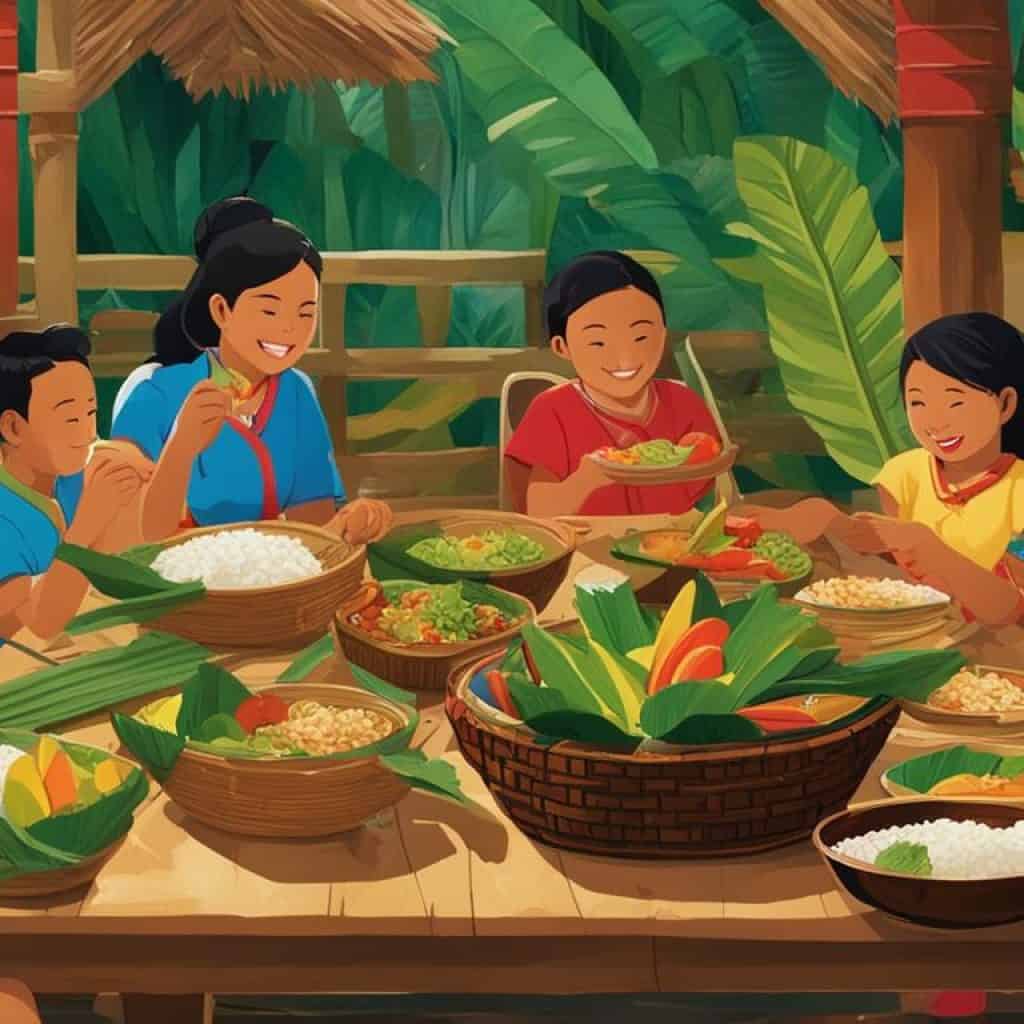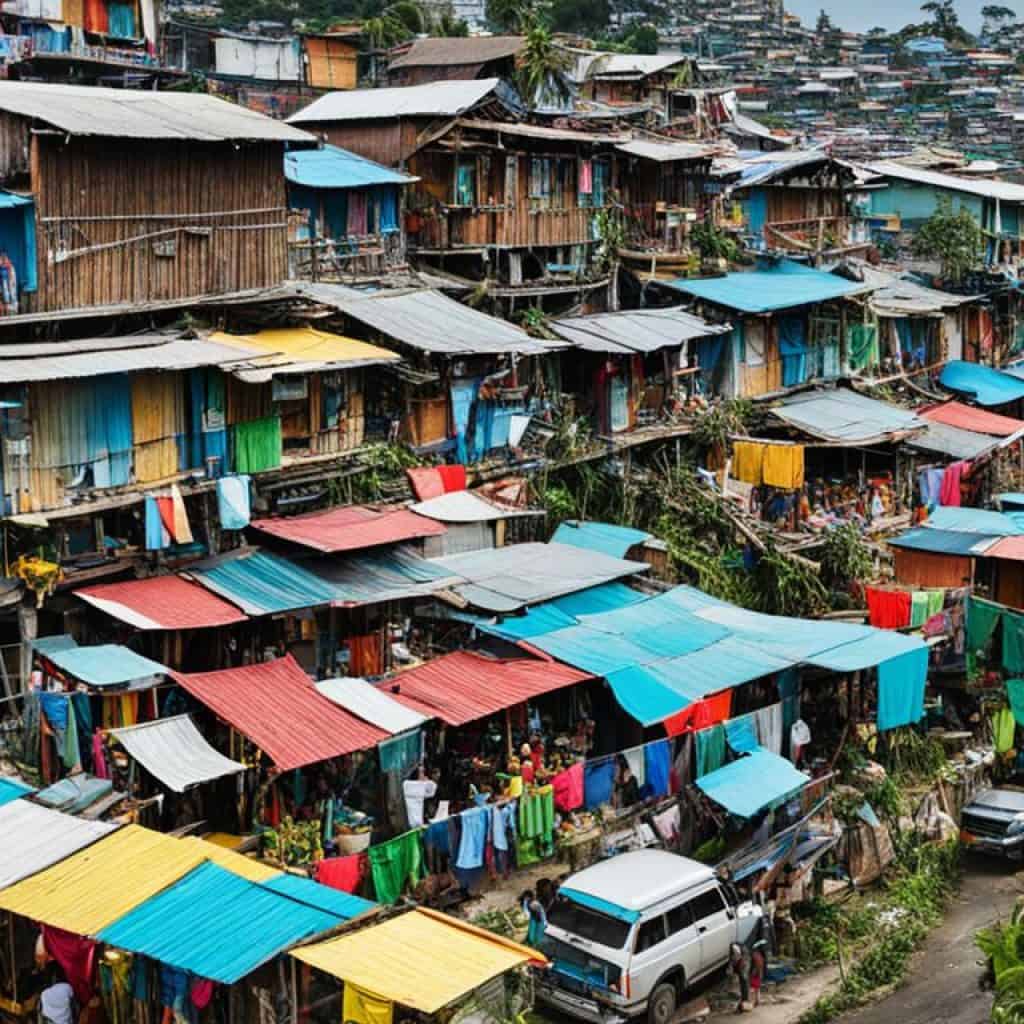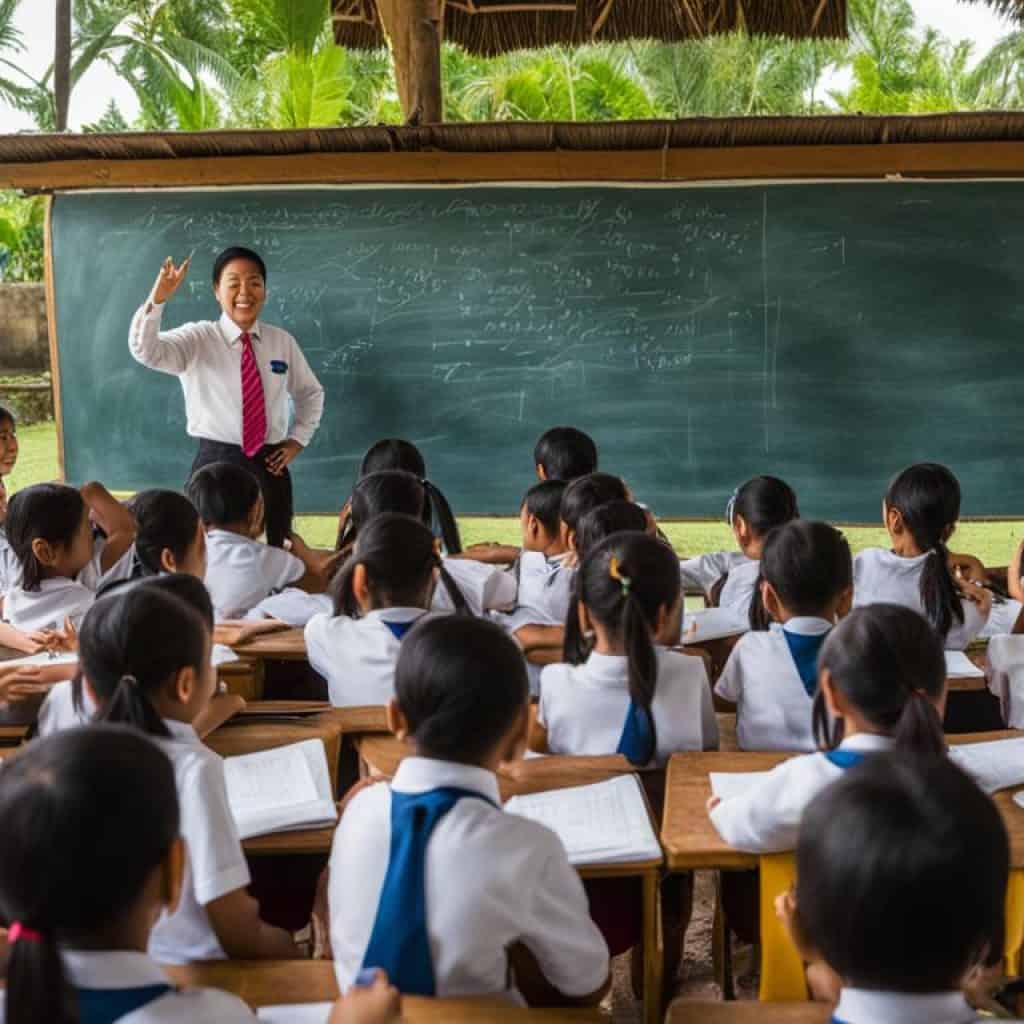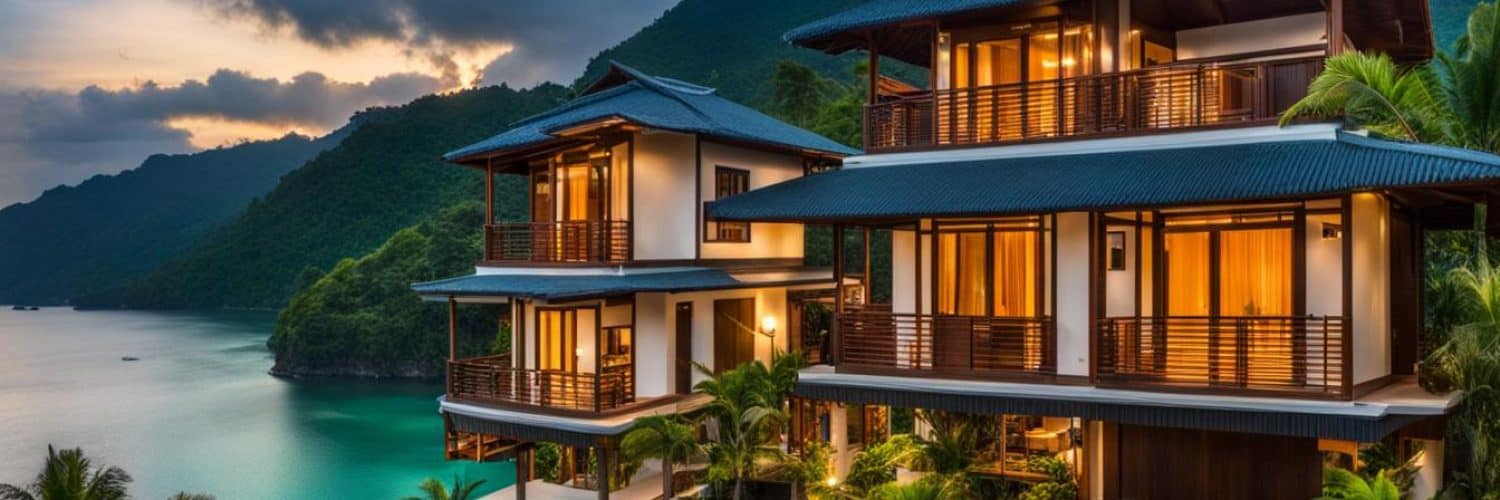Have you ever wondered where the vibrant and diverse country of the Philippines is located? Or perhaps you’re curious about the unique lifestyle and culture of the Filipino people? In this article, we will explore the fascinating world of the Philippines and uncover the secrets of where this archipelago nation truly lives.
Key Takeaways:
- t
- The Philippines is an archipelago consisting of over 7,000 islands located in Southeast Asia. t
- Manila is the capital city, while Quezon City is the most populous city in the Philippines. t
- The country is bounded by the South China Sea, the Philippine Sea, and the Celebes Sea. t
- The Philippines has a diverse population, with Filipinos predominantly of Malay descent but with various cultural influences. t
- Join us as we dive into the rich history, geography, culture, and lifestyle of the Philippines and discover what makes it such a remarkable place to live.
Philippine History and Government
The Philippines has a rich and complex history that encompasses centuries of indigenous heritage, Spanish colonization, and the pursuit of independence. Understanding Philippine history is integral to appreciating Filipino culture and the country’s present-day government.
Spanish Colonization
Spanish explorer Ferdinand Magellan arrived in the Philippines in 1521, marking the beginning of over 300 years of Spanish colonization. During this period, Catholicism became the dominant religion, and Spanish culture and language heavily influenced the Filipino people. The Spanish introduced a centralized form of governance and established cities, forts, and churches throughout the archipelago.
Philippine Revolution
The desire for independence grew among the Filipino population, leading to the Philippine Revolution against Spanish rule. On June 12, 1898, the Philippines declared independence, but it was not recognized by Spain or the United States.
Spanish-American War and American Colonization
The Philippine Revolution coincided with the Spanish-American War, during which the United States defeated Spain. As a result, Spain ceded the Philippines to the United States. American colonization lasted until July 4, 1946, when the Philippines gained full independence.
The Philippine Government Today
The Philippines is now a unitary presidential constitutional republic with a democratic government. It follows a multi-party system, and the President serves as both the head of state and the head of government. The government is divided into three branches: the executive, legislative, and judicial. The Constitution of the Philippines defines the powers and responsibilities of each branch, ensuring a system of checks and balances.
| Government Type | Branches | Leader |
|---|---|---|
| Unitary Presidential Constitutional Republic |
| President Rodrigo Duterte |
The table above provides an overview of the Philippine government structure and its leader.
“The history of the Philippines is a testament to the resilience and determination of the Filipino people in their quest for independence and self-governance.”
Geography and Climate
The Philippines is an archipelago of 7,641 islands comprising three main geographical divisions: Luzon, Visayas, and Mindanao. The largest islands are Luzon and Mindanao. With its strategic location in Southeast Asia, the country is surrounded by the Philippine Sea, South China Sea, and Pacific Ocean, making it a maritime gateway to the region.
The Philippines boasts diverse landscapes, from stunning mountains and volcanoes to picturesque coastal plains and breathtaking coral reefs. The geography of the country offers a wide range of natural wonders to explore, making it a paradise for outdoor enthusiasts and nature lovers.
Luzon and Mindanao are the two largest islands in the Philippines. The country is surrounded by the Philippine Sea, South China Sea, and Pacific Ocean, offering an abundance of marine resources and trade opportunities.
The tropical climate of the Philippines is characterized by high humidity, warm temperatures, and distinct wet and dry seasons. The country experiences a high frequency of typhoons, especially during the monsoon season from June to November. These typhoons can bring heavy rainfall, strong winds, and storm surges, affecting various parts of the country.
Fascinating Facts about the Geography of the Philippines:
- The Philippines is an archipelago consisting of over 7,000 islands, offering countless serene beaches and beautiful coastlines to explore.
- The Philippine Trench, located in the Philippine Sea, is one of the deepest parts of the world’s oceans, reaching a depth of approximately 10,000 meters.
- The country is home to breathtaking natural wonders, such as the stunning Chocolate Hills in Bohol and the enchanting Underground River in Palawan, which is recognized as one of the New 7 Wonders of Nature.
“The Philippines is a treasure trove of geographical wonders, from its lush mountains to its vibrant coral reefs. Exploring its diverse landscapes is like stepping into a paradise that never ceases to awe.” – Travel Enthusiast
| Geographical Information | Facts |
|---|---|
| Number of Islands | 7,641 |
| Main Geographical Divisions | Luzon, Visayas, Mindanao |
| Area | 300,000 square kilometers |
| Highest Peak | Mount Apo (Mindanao) – 2,954 meters |
| Longest River | Cagayan River (Northern Luzon) – 505 kilometers |
| Tropical Climate | High humidity, warm temperatures; wet and dry seasons; frequent typhoons from June to November |
Filipino culture is a vibrant tapestry woven with indigenous, Spanish, American, and other Asian influences. The Filipino people take great pride in their rich traditions and customs, which are deeply rooted in their strong family ties and sense of community.
The Philippines is a linguistically diverse country, with over 180 languages spoken throughout its archipelago. The official languages are Filipino, which is based on Tagalog, and English. Filipino serves as a national language and is taught in schools, while English is widely spoken and understood, making communication with locals and expats easier.
The Philippines is also a country that loves to celebrate. Throughout the year, various festivals and fiestas take place, each showcasing different aspects of Filipino culture. Colorful costumes, traditional dances, and vibrant music fill the streets during festivals like Sinulog in Cebu and Ati-Atihan in Kalibo.

“Filipino culture is a tapestry woven with indigenous, Spanish, American, and other Asian influences.”
Filipino Traditions
Filipino traditions play a significant role in everyday life and special occasions. Respect for elders, close-knit family relationships, and hospitality are highly valued. Celebrations such as weddings, birthdays, and Christmas are important events that bring families and communities together.
Sample of Filipino Cuisine
| Dish | Description |
|---|---|
| Adobo | A savory dish typically made with marinated meat (usually pork or chicken) simmered in vinegar, soy sauce, garlic, and spices. |
| Sinigang | A sour soup made with tamarind or other souring agents, combined with meat or seafood, vegetables, and spices. |
| Lechon | A whole roasted pig that is seasoned and cooked over an open fire, resulting in crispy skin and tender, flavorful meat. |
“The Philippines is a country that loves to celebrate, with vibrant festivals showcasing different aspects of Filipino culture.”
Filipino Festivals
The Philippines is known for its colorful and lively festivals, which reflect the country’s unique cultural heritage. These festivals are a fusion of traditional dances, music, costumes, and religious rituals. Here are a few notable festivals:
- Sinulog Festival РA grand celebration in Cebu City that honors the Santo Ni̱o (Child Jesus). It features street parades, dance competitions, and religious processions.
- Ati-Atihan Festival РHeld in Kalibo, Aklan, this festival pays homage to the Sto. Ni̱o and commemorates the ancient pact between the locals and Malay settlers as they share food, drinks, and dances.
- Pahiyas Festival – Celebrated in Lucban, Quezon, this festival showcases colorful and creative displays of rice, fruits, vegetables, and handicrafts as a thanksgiving for a bountiful harvest.
These festivals are not only a way to celebrate and showcase Filipino culture, but they also attract tourists from around the world who are captivated by the vibrant and joyful atmosphere.
Popular Cities in the Philippines
The Philippines is a country that offers a diverse range of cities, each with its own unique charm and character. Whether you’re looking for a bustling metropolis or a serene coastal town, the Philippines has something to offer. Here are some popular cities that are worth considering:
1. Manila
“The city of Manila is the capital of the Philippines and serves as the country’s political, economic, and cultural center. It is a vibrant metropolis that combines modern skyscrapers with historical landmarks.”
Manila is known for its rich history, with attractions such as Intramuros, a walled city built during the Spanish colonial era, and Rizal Park, a memorial park dedicated to the country’s national hero. The city also offers a bustling nightlife scene, shopping malls, and a variety of culinary experiences.
2. Quezon City
“Adjacent to Manila, Quezon City is the most populous city in the Philippines and a major center for business and entertainment. It offers a mix of residential areas, commercial districts, and entertainment complexes.”
Quezon City is home to numerous shopping malls, restaurants, and entertainment venues. It is also known for its educational institutions and cultural attractions, such as the Quezon Memorial Circle and the University of the Philippines Diliman campus.
3. Cebu City
“Cebu City is a vibrant and cosmopolitan city located in the Visayas region. It is known for its beautiful beaches, historical landmarks, and vibrant nightlife.”
Cebu City offers a range of attractions, including the iconic Magellan’s Cross, Fort San Pedro, and the Basilica Minore del Santo Niño. The city is also a hub for trade and commerce, with shopping centers and business districts.
4. Davao City
“Davao City is a bustling urban center located in Mindanao, offering a mix of modern amenities and natural beauty. It is known for its pristine beaches, vibrant markets, and outdoor adventure opportunities.”
Davao City is home to attractions such as the Philippine Eagle Center, Mount Apo (the highest mountain in the Philippines), and the bustling Davao Crocodile Park. The city also offers a range of shopping malls, restaurants, and cultural events.
These cities not only provide a variety of job opportunities and amenities but also offer a glimpse into the unique culture and lifestyle of the Philippines. Whichever city you choose, you can expect a warm welcome from the friendly Filipino locals and a vibrant cosmopolitan experience.
| City | Attractions | Notable Features |
|---|---|---|
| Manila | Intramuros, Rizal Park, shopping malls, vibrant nightlife | Historical landmarks, diverse culinary scene |
| Quezon City | Quezon Memorial Circle, University of the Philippines Diliman campus, shopping malls | Educational institutions, entertainment complexes |
| Cebu City | Magellan’s Cross, Fort San Pedro, beautiful beaches | Historical landmarks, vibrant nightlife |
| Davao City | Philippine Eagle Center, Mount Apo, outdoor adventure opportunities | Natural beauty, cultural events |
These cities are just a glimpse of the many gems that the Philippines has to offer. Whether you’re seeking a bustling city life, a beachfront retreat, or a mix of both, the popular cities in the Philippines are sure to provide a vibrant and dynamic living experience.
Best Places to Live in the Philippines
Are you considering a move to the Philippines? With its stunning natural beauty, warm climate, and friendly locals, it’s no wonder that more and more expats and retirees are choosing to make this country their home. From expat-friendly communities to affordable living costs, there are several places in the Philippines that offer a great quality of life. Here are some of the best places to live in the Philippines:
1. Subic
Located northwest of Manila, Subic is known for its expat-friendly environment and proximity to beautiful beaches. This former US naval base has been transformed into a thriving community with international schools, hospitals, and recreational facilities. With its relaxed lifestyle and affordable cost of living, Subic is a popular choice for expats and retirees.
2. Tagaytay
If you prefer a cooler climate, Tagaytay is an excellent option. Situated in the highlands of Luzon, this city offers breathtaking views of Taal Lake and Volcano. Tagaytay is renowned for its fresh produce and organic farms, making it a haven for nature lovers and those seeking a healthy lifestyle.
3. Dumaguete
Nestled on the island of Negros Oriental, Dumaguete is known as the “City of Gentle People.” It boasts a relaxed atmosphere, low crime rate, and a welcoming community. Expats and retirees are drawn to Dumaguete for its affordable healthcare, tropical climate, and vibrant local culture.
In addition to these top picks, other notable cities such as Cebu City and Davao City also offer a high quality of life with modern amenities and a cosmopolitan lifestyle. When choosing a place to live in the Philippines, it’s important to consider factors such as the cost of living, proximity to healthcare facilities, safety, and the overall lifestyle that suits your preferences.
Table: Comparison of Best Places to Live in the Philippines
| Place | Cost of Living | Climate | Proximity to Healthcare Facilities | Safety |
|---|---|---|---|---|
| Subic | Affordable | Tropical | Close | Safe |
| Tagaytay | Moderate | Cool | Nearby | Safe |
| Dumaguete | Affordable | Tropical | Accessible | Safe |
Living in the Philippines offers a unique experience filled with natural beauty, warm hospitality, and a relaxed lifestyle. Whether you’re an expat looking for a friendly community or a retiree seeking an affordable and comfortable retirement, the Philippines has something to offer. Take your time to research and consider the best place that suits your needs and preferences.
Housing in the Philippines
When it comes to housing options in the Philippines, there is something to suit every lifestyle and budget. From apartments and condominiums in bustling urban areas to houses and beachfront properties in serene rural locations, individuals have a range of choices to consider. Whether you are a local resident or an expat, the real estate market in the Philippines offers opportunities for both renting and buying property.
Renting is a popular option for individuals who prefer flexibility or are new to the country. It allows for easier relocation and does not require a long-term commitment. Rental prices vary depending on the location, size, and condition of the property. For those looking for temporary accommodation or exploring different areas before making a long-term commitment, renting is a convenient choice.
On the other hand, buying property in the Philippines can be a wise long-term investment. It provides stability and the opportunity to build equity over time. Real estate prices can vary significantly depending on the location, property type, and other factors such as proximity to schools, hospitals, and amenities. It is important to conduct thorough research and consider factors such as potential growth in the area, property value trends, and legal obligations before making a purchase.
The Philippines offers a variety of housing options to cater to different preferences and budgets. Here are some of the common types of housing in the country:
- Townhouses: These are narrow and multi-level homes that are typically part of a larger complex. They are a popular choice among families looking for more space and privacy than apartments offer.
- Bungalows: Bungalows are single-story houses that are ideal for individuals or smaller families. They often feature open floor plans and provide a sense of convenience and accessibility.
- High-rise Condominiums: These residential buildings offer the convenience of urban living with amenities such as swimming pools, fitness centers, and security services. They are popular in major cities and cater to individuals or families seeking a modern lifestyle.
Here is a table comparing the average prices of different types of properties in popular areas of the Philippines:
| Property Type | Metro Manila | Cebu City | Palawan |
|---|---|---|---|
| Townhouse | $100,000 – $250,000 | $80,000 – $200,000 | $60,000 – $150,000 |
| Bungalow | $150,000 – $400,000 | $120,000 – $300,000 | $80,000 – $200,000 |
| High-rise Condominium | $50,000 – $300,000 | $40,000 – $200,000 | $30,000 – $150,000 |
| Beachfront Property | $200,000 – $2,000,000 | $150,000 – $1,500,000 | $100,000 – $1,000,000 |
Here is a quote from Jane Reyes, a real estate agent specializing in the Philippines market: “The Philippine real estate market offers a wide range of options for individuals looking to rent or buy property. From affordable apartments to luxurious beachfront villas, there is a place for everyone. It’s important to work with a trusted real estate agent who can guide you through the process and help you find the perfect home.”
Whether you choose to rent or buy, housing in the Philippines provides a variety of options to suit different lifestyles and budgets. From urban centers to picturesque coastal towns, the country’s real estate market offers something for everyone.

Stay tuned for the next section where we will discuss job opportunities in the Philippines and the various industries that thrive in the country.
Job Opportunities in the Philippines
The Philippines offers a wide range of job opportunities across various industries. With a skilled workforce and proficiency in English, the country has become a popular destination for international companies outsourcing their operations. Expats looking to work in the Philippines can explore careers in sectors such as:
- Information Technology and Business Process Outsourcing (IT-BPO)
- Manufacturing
- Tourism
- Healthcare
- Education
The IT-BPO industry is one of the fastest-growing sectors in the Philippines, providing job opportunities for professionals in software development, customer service, and digital marketing. Manufacturing also plays a significant role in the country’s economy, with job prospects in automotive, electronics, and pharmaceutical industries.
The Philippines’ tourism sector offers employment opportunities in hospitality, travel agencies, and tour operators. With its stunning natural attractions and vibrant culture, the country attracts both local and international tourists.
The healthcare industry is another growing sector, with demand for skilled medical professionals and healthcare workers. The Philippines is known for its quality healthcare services and medical tourism industry.
Education is also a thriving sector, with universities and international schools providing opportunities for teachers and administrators. English proficiency among Filipinos makes it an ideal location for teaching English as a second language.
Other job opportunities in the Philippines exist in fields such as engineering, finance, marketing, and human resources. The country’s strong economic growth and favorable business environment create a dynamic job market, offering plenty of career prospects.
Whether you are a local or an expat, exploring job opportunities in the Philippines can provide a rewarding career in a vibrant and diverse environment.
Cost of Living in the Philippines
Considering the cost of living is an important aspect when planning to move to the Philippines. Compared to many Western countries, the cost of living in the Philippines is generally lower. Affordable housing and groceries can be found, especially in provincial areas. However, it’s important to note that the cost of utilities, transportation, and healthcare may vary depending on the location.
Salaries in the Philippines can also vary, with higher wages typically found in metropolitan areas. It’s essential for individuals considering a move to the Philippines to carefully consider their budget and adjust their lifestyle accordingly. By managing expenses wisely, affordable living in the Philippines can be achieved without compromising the quality of life.
Living Expenses in the Philippines
Living expenses in the Philippines can vary based on personal preferences and choices. Here are some common living expenses to consider:
- Housing: Rent or mortgage payments, utilities, and maintenance costs.
- Groceries: Cost of food, beverages, and household essentials.
- Transportation: Commuting expenses, including fuel, public transportation fares, or car maintenance.
- Healthcare: Medical expenses, insurance premiums, and regular check-ups.
- Education: Tuition fees, school supplies, and extracurricular activities for children.
- Entertainment: Dining out, leisure activities, and entertainment options.
Average Salary in the Philippines
The average salary in the Philippines varies depending on the industry and occupation. Higher wages are typically found in metropolitan areas and industries such as IT and BPO, finance, and engineering. It’s important to research and consider job opportunities and salary scales in the specific field of interest.
| Expense Category | Philippines | United States | United Kingdom |
|---|---|---|---|
| Housing (Monthly Rent) | $500 | $1,500 | $2,000 |
| Groceries (Monthly) | $200 | $400 | $500 |
| Transportation (Monthly) | $50 | $150 | $200 |
| Healthcare (Monthly) | $100 | $300 | $400 |
| Entertainment (Monthly) | $100 | $300 | $400 |
“The cost of living in the Philippines offers a more affordable lifestyle compared to many Western countries. With lower housing and grocery expenses, individuals can enjoy a comfortable life without breaking the bank. By carefully managing expenses and making informed choices, it is possible to achieve affordable living in the Philippines.”
Retirement Living in the Philippines
The Philippines has become a popular retirement destination for expats due to its affordable cost of living, warm climate, and friendly locals. Retiring abroad in the Philippines offers retirees a chance to enjoy their golden years in a tropical paradise at a fraction of the cost compared to many Western countries.
One of the key benefits for retirees looking to settle in the Philippines is the retirement visa program called the Special Resident Retiree’s Visa (SRRV). This program provides eligible retirees with a range of benefits, including tax exemptions and the option to work or invest in the country. The retirement visa makes it easier for retirees to enjoy their new life in the Philippines without the hassle of constantly renewing their stay.
Retirees in the Philippines can enjoy a relaxed and comfortable lifestyle. With its warm climate, retirees have the opportunity to spend their days golfing on beautiful courses, lounging on pristine beaches, and indulging in a variety of outdoor activities. The Philippines offers a range of amenities and services catered to the expat community, including beach resorts, social clubs, and healthcare facilities.
“Retiring in the Philippines allows you to enjoy a laid-back lifestyle in a beautiful setting. The welcoming locals and vibrant expat community make it easy to make new friends and embrace the local culture.”
Living expenses in the Philippines are generally affordable, allowing retirees to stretch their retirement savings. The cost of housing, groceries, and transportation is lower compared to many Western countries. Healthcare in the Philippines is also accessible and affordable, with a mix of public and private healthcare facilities available.
Retiring in the Philippines also offers retirees the opportunity to explore a new culture and way of life. The Philippines has a rich history, diverse cuisine, and vibrant festivals that retirees can immerse themselves in. Whether it’s enjoying local delicacies like adobo and halo-halo or participating in colorful cultural celebrations like the Sinulog Festival, retirees will never run out of new experiences to enjoy.
Overall, retirement living in the Philippines provides a unique and fulfilling experience for expats. With its affordable cost of living, warm climate, and welcoming locals, the Philippines is an ideal destination for retirees looking for a peaceful and enjoyable retirement abroad.
| Retirement Benefits in the Philippines | Details |
|---|---|
| Tax Exemptions | Retirees with the Special Resident Retiree’s Visa (SRRV) enjoy tax exemptions on their foreign-sourced income. |
| Ability to Work or Invest | Retirees with the SRRV have the option to work or invest in the Philippines, providing additional income opportunities. |
| Healthcare Services | The Philippines offers a mix of public and private healthcare facilities, providing retirees with accessible and affordable healthcare services. |
| Expatriate Community | The Philippines has a vibrant expat community, with social clubs and organizations that provide support and camaraderie for retirees. |
Retirement Visa in the Philippines
The Special Resident Retiree’s Visa (SRRV) is a retirement visa program offered by the Philippine government. It provides eligible foreigners with a range of benefits, making retirement living in the Philippines more convenient and enjoyable:
- Multiple Entry Privileges: Retirees with the SRRV can enter and exit the Philippines without the need for a separate visa.
- Tax Exemptions: Retirees enjoy tax exemptions on their foreign-sourced income, providing significant savings.
- Option to Work or Invest: The SRRV allows retirees to work or invest in the Philippines, providing additional income opportunities.
- Permanent Residency: After three years of continuous stay in the Philippines, retirees with the SRRV may be eligible to apply for permanent residency.
By obtaining the retirement visa, retirees can fully embrace retirement living in the Philippines and take advantage of the benefits and opportunities available to them.
Factors to Consider Before Moving to the Philippines
Before making the decision to move to the beautiful Philippines, it is essential to consider various factors that will contribute to a smooth transition and a fulfilling expat life. Cultural adjustment, healthcare options, and safety are paramount concerns that expats should prioritize.
Cultural Adjustment
Living in a new country often entails adapting to a different culture and way of life. Embracing the Filipino culture and customs can enhance the expat experience and foster deeper connections with the local community. Take the time to learn about Filipino traditions, etiquette, and social norms to facilitate a smoother integration into the local society.
Healthcare in the Philippines
Prioritizing healthcare is crucial when moving to a new country. In the Philippines, it is recommended to research available healthcare options and consider obtaining comprehensive health insurance to ensure access to quality medical services. Familiarize yourself with local hospitals, clinics, and medical facilities in your chosen area.
Safety in the Philippines
As with any country, safety is a vital consideration. While the Philippines is generally safe, it is important to exercise caution and be aware of your surroundings. Stay informed about any potential risks or travel advisories and take necessary precautions to protect yourself and your belongings. Familiarize yourself with local emergency numbers and keep important contacts readily accessible.
Tip: Remaining vigilant and informed can contribute to a safe and enjoyable experience while living in the Philippines.
Research Local Laws and Regulations
Understanding the local laws and regulations is essential to avoid any legal issues or misunderstandings. Familiarize yourself with specific rules and regulations that may affect your stay, such as visa requirements, property ownership, and employment regulations. Seeking legal advice or guidance from reputable sources can help navigate these matters effectively.
Education in the Philippines
The Philippines has a well-established education system that offers a variety of educational opportunities for students. Both public and private schools are available, providing options for students to pursue their academic goals.
Elementary education in the Philippines is mandatory and lasts for six years. During this stage, students acquire basic knowledge and skills in various subjects such as Mathematics, Science, Languages, and Social Studies.
Secondary education follows elementary school and is also compulsory, lasting for four years. In this stage, students continue to develop their knowledge and skills in a more specialized curriculum.
Throughout their academic journey, students have the option to pursue higher education in numerous universities and colleges across the country. These institutions provide a wide range of programs and degrees, allowing students to choose their preferred field of study.
Furthermore, the Philippines is home to international schools that cater to expat families. These schools follow international curricula such as the International Baccalaureate (IB) or American curriculum, ensuring that students receive a quality education that prepares them for global opportunities.
Education is a key investment in the future. It equips students with the necessary knowledge, skills, and values to succeed in life. The Philippines offers a diverse range of educational options, ensuring that every student has the opportunity to reach their full potential.
Table: Overview of Education Levels in the Philippines
| Education Level | Duration | Age Range | Remarks |
|---|---|---|---|
| Elementary | 6 years | 6-12 | Compulsory |
| Secondary | 4 years | 13-16 | Compulsory |
| Higher Education | Varies | Above 16 | Includes universities and colleges |
Image:
Tourism and Travel in the Philippines
The Philippines is a breathtaking destination that offers stunning natural beauty, picturesque beaches, and an abundance of marine life, making it a haven for tourists. Whether you’re looking for a relaxing beach getaway, an adventure-filled island hopping experience, or a glimpse into the country’s rich history and culture, the Philippines has something for everyone.
One of the most popular tourist destinations in the Philippines is Boracay, known for its world-famous white sand beaches. With crystal clear waters and a vibrant nightlife, Boracay attracts visitors from all over the globe. Palawan, another must-visit destination, boasts stunning landscapes, including the stunningly beautiful Puerto Princesa Subterranean River and the iconic limestone cliffs of El Nido.
For history buffs, Manila offers a wealth of historical sites and landmarks, such as Intramuros, a walled Spanish colonial city, and Rizal Park, a national monument dedicated to the country’s national hero, Jose Rizal.
When traveling to the Philippines, it’s important to take necessary precautions for your safety. Stay informed about travel advisories, respect local customs and traditions, and ensure you have appropriate health and safety measures in place. Engaging in sustainable tourism practices, such as respecting and preserving the natural environment, is also essential in helping preserve the beauty of the country for future generations.
Travel Tips for the Philippines:
- Research and plan your itinerary in advance to make the most of your trip.
- Check travel advisories and be aware of any safety concerns in the areas you plan to visit.
- Respect local customs and traditions, and dress modestly when visiting religious sites.
- Stay hydrated and protect yourself from the sun by wearing sunscreen and a hat.
- Try local cuisine and street food, but make sure to eat at clean and reputable establishments.
- Be cautious of your belongings and avoid displaying valuable items.
- Learn a few basic phrases in Filipino or the local dialect to facilitate communication.
By following these travel tips and immersing yourself in the beauty and culture of the Philippines, you’ll create unforgettable memories and have a truly remarkable experience.
| Tourist Destinations | Description |
|---|---|
| Boracay | World-famous white sand beaches and vibrant nightlife |
| Palawan | Picturesque landscapes and natural wonders |
| Manila | Rich history, cultural sites, and bustling city life |
| Cebu | Beautiful beaches, historical landmarks, and vibrant city vibes |
| Bohol | Tropical paradise with stunning beaches and unique attractions like the Chocolate Hills and tarsier sanctuaries |
Filipino Cuisine and Festivals
Filipino cuisine is a delightful fusion of flavors and influences from various cultures. It reflects the country’s rich history and diverse heritage. From savory dishes to sweet treats, Filipino food offers a unique gastronomic experience.
Popular Filipino dishes include:
Adobo: A flavorful dish made with marinated meat, usually chicken or pork, cooked in a tangy sauce of vinegar, soy sauce, garlic, and spices.
Sinigang: A delicious sour soup made with tamarind, tomatoes, and various vegetables. It is often cooked with shrimp, pork, or beef.
Lechon: A mouthwatering roasted pig, known for its crispy skin and tender meat. It is often served as the centerpiece of festive occasions.
Pancit: A popular noodle dish that comes in different varieties, such as pancit canton, pancit bihon, and pancit palabok. It is often enjoyed during birthdays and other special gatherings.
While these dishes are enjoyed in homes and restaurants, Filipino street food holds a special place in the hearts (and stomachs) of locals and tourists alike. Some must-try street food favorites include:
- Balut: A unique delicacy consisting of a developing duck embryo, boiled and eaten as a snack.
- Isaw: Grilled chicken intestines, usually marinated and skewered for a smoky and flavorful bite.
- Halo-halo: A refreshing dessert made with shaved ice, assorted sweet beans, jelly, fruit, and topped with leche flan and ice cream.
These street food delights offer an authentic taste of Filipino culture and are best enjoyed while exploring the bustling streets and vibrant markets.
The Philippines is also renowned for its vibrant festivals, which celebrate the country’s rich cultural heritage and traditions. These festivals showcase colorful parades, traditional dances, lively music, and intricate costumes. Two notable festivals are:
- Sinulog Festival (Cebu): A grand celebration held in Cebu City every January, honoring the Santo Niño (Child Jesus). It features street dancing, religious processions, and a fluvial parade.
- Ati-Atihan Festival (Kalibo): A lively festival held in Kalibo, Aklan every January, known as the “Mother of Philippine Festivals.” Participants paint their faces with black soot and dress in indigenous Aeta costumes, reenacting the arrival of Malay settlers and paying homage to the Santo Niño.
These cultural festivals provide a glimpse into the vibrant traditions and strong community spirit of the Filipino people.
| Festival | Location | Date |
|---|---|---|
| Sinulog Festival | Cebu City | January |
| Ati-Atihan Festival | Kalibo | January |
Conclusion
The Philippines, with its unique and diverse lifestyle, offers a multitude of opportunities for individuals seeking to live, work, or retire in this beautiful country. From the bustling cities of Manila and Quezon City to the serene islands and breathtaking beaches, the Philippines has something to cater to the preferences of every individual.
One of the major advantages of living in the Philippines is the generally affordable cost of living, which allows people to enjoy a comfortable lifestyle without breaking the bank. The country’s warm tropical climate creates a pleasant environment throughout the year, making it an ideal destination for those seeking a relaxed and enjoyable outdoor lifestyle.
However, before making the decision to move to the Philippines, it is crucial to consider various factors such as cultural adjustment, healthcare facilities, and safety. Adapting to a new culture may require some time and effort, but the friendly and hospitable nature of the Filipino people can help ease the transition.
Additionally, obtaining comprehensive health insurance coverage and familiarizing oneself with the local healthcare system are essential for ensuring access to quality medical care. It is also recommended to exercise caution and be aware of one’s surroundings to maintain personal safety in the country.
With proper planning and preparation, the Philippines can offer an exciting and rewarding lifestyle to those who choose to reside here. From the vibrant city life to the serene natural landscapes, the Philippines truly captures the essence of a diverse and captivating lifestyle.
FAQ
Where is the Philippines located?
The Philippines is an archipelago located in Southeast Asia, with over 7,000 islands. It is bounded by the South China Sea, the Philippine Sea, and the Celebes Sea.
What is the capital city of the Philippines?
The capital city of the Philippines is Manila.
What are some popular cities in the Philippines?
Popular cities in the Philippines include Manila, Quezon City, Cebu City, and Davao City.
What is the cost of living in the Philippines?
The cost of living in the Philippines is generally lower compared to many Western countries. Housing and groceries tend to be affordable, while utilities, transportation, and healthcare may vary depending on the location.
Are there expat-friendly areas in the Philippines?
Yes, there are several expat-friendly areas in the Philippines, such as Subic, Tagaytay, and Dumaguete. These places offer a relaxed lifestyle, affordable cost of living, and proximity to beautiful natural scenery.
What are the job opportunities in the Philippines?
The Philippines has a diverse job market, with opportunities in industries such as information technology, manufacturing, tourism, healthcare, and education. It is known for its skilled workforce and proficiency in English.
What are the factors to consider before moving to the Philippines?
Before moving to the Philippines, it is important to consider factors such as cultural adjustment, healthcare options, safety, and familiarity with local laws and regulations.
What types of housing are available in the Philippines?
Housing options in the Philippines range from apartments and condominiums in urban areas to houses and beachfront properties in rural areas. Real estate is available for both renting and buying.
Is the Philippines a good place for retirement?
Yes, the Philippines has become a popular retirement destination for expats due to its affordable cost of living, warm climate, and friendly locals. The government offers a retirement visa program with various benefits for eligible retirees.
What is the education system like in the Philippines?
The Philippines has a well-established education system that provides both public and private schooling options. Elementary and secondary education are mandatory. The country is also home to numerous universities and colleges.
What are some popular tourist destinations in the Philippines?
Popular tourist destinations in the Philippines include Boracay, Palawan, and Manila. The country offers stunning natural beauty, pristine beaches, historical sites, and vibrant festivals.
What is Filipino cuisine known for?
Filipino cuisine is known for its diverse flavors and dishes, influenced by indigenous, Spanish, American, and other Asian cultures. Popular dishes include adobo, sinigang, and lechon.
What should I know about the lifestyle in the Philippines?
The Philippines offers a unique and diverse lifestyle, with opportunities for city living or a more relaxed and beach-oriented lifestyle. The cost of living is generally affordable, and the country has a warm climate and rich culture.


















Add comment